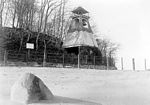Whitestone, Queens

Whitestone is a residential neighborhood in the northernmost part of the New York City borough of Queens. The neighborhood proper is located between the East River to the north; College Point and Whitestone Expressway to the west; Flushing and 25th Avenue to the south; and Bayside and Francis Lewis Boulevard to the east. Whitestone contains the subsection of Malba, which is bounded to the north by the East River, to the east by the Whitestone Expressway, to the south by 14th Avenue, and to the west by 138th Street. Malba was cited in a New York Times article as one of the few "elite enclaves" of Queens.Whitestone is located in Queens Community District 7 and its ZIP Code is 11357. It is patrolled by the New York City Police Department's 109th Precinct. Politically, Whitestone is represented by the New York City Council's 19th District.
Excerpt from the Wikipedia article Whitestone, Queens (License: CC BY-SA 3.0, Authors, Images).Whitestone, Queens
152nd Street, New York Queens
Geographical coordinates (GPS) Address Nearby Places Show on map
Geographical coordinates (GPS)
| Latitude | Longitude |
|---|---|
| N 40.79 ° | E -73.81 ° |
Address
152nd Street 12-59
11357 New York, Queens
New York, United States
Open on Google Maps





